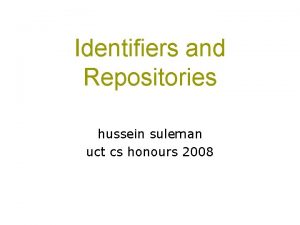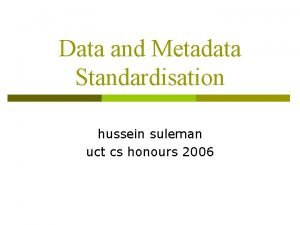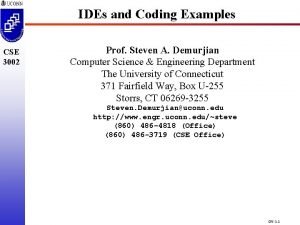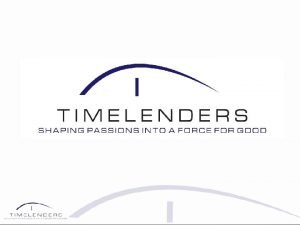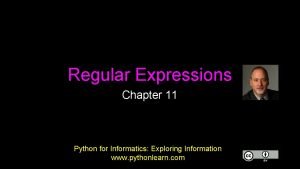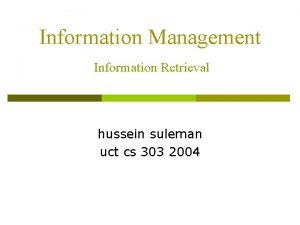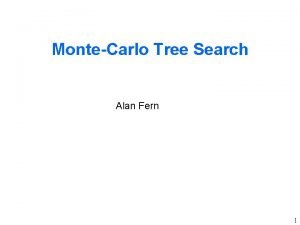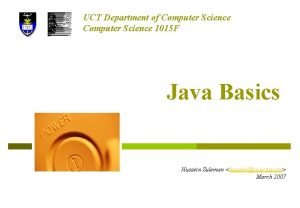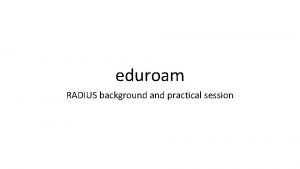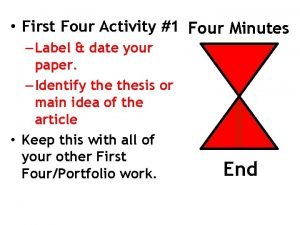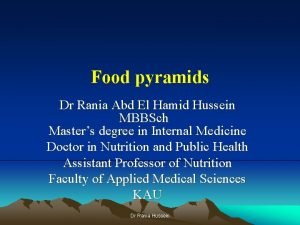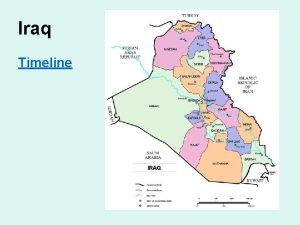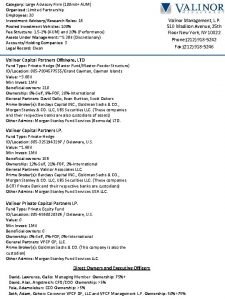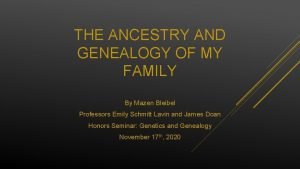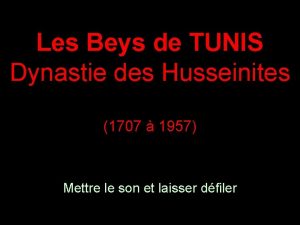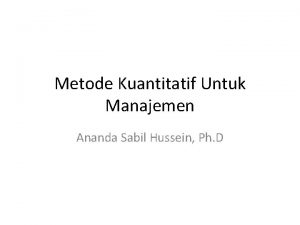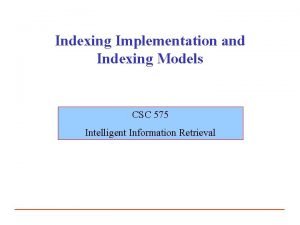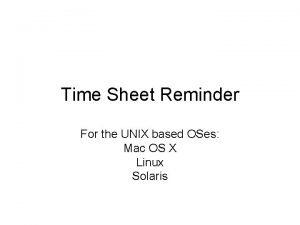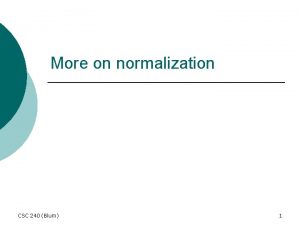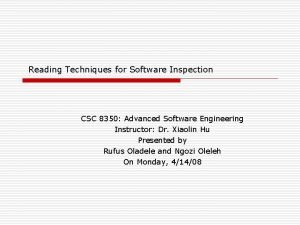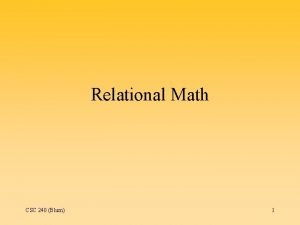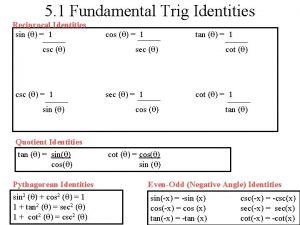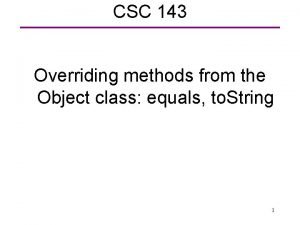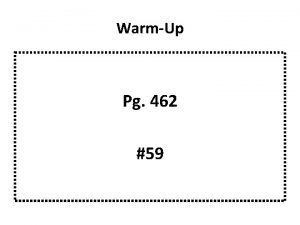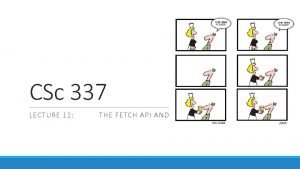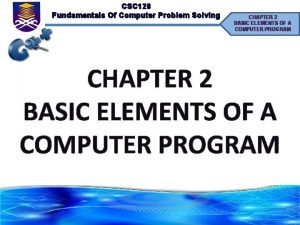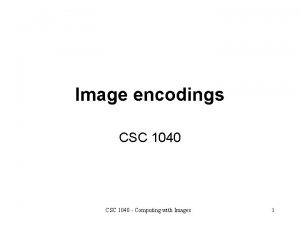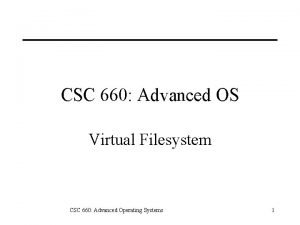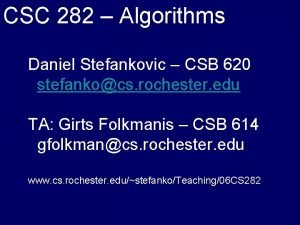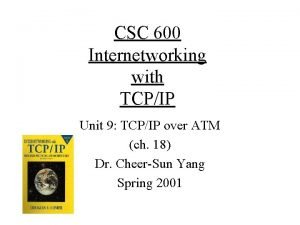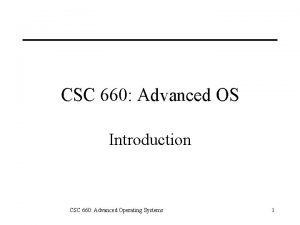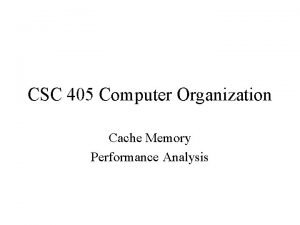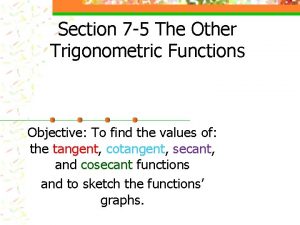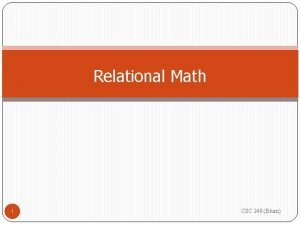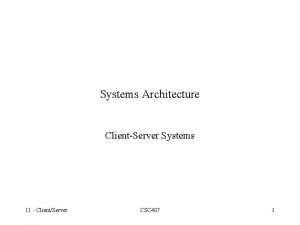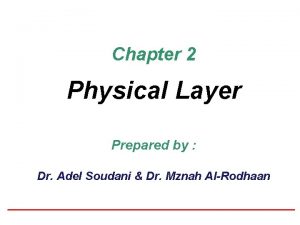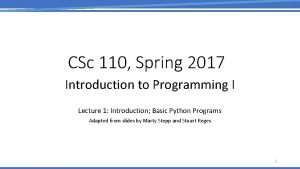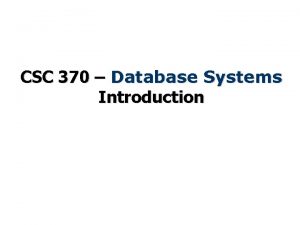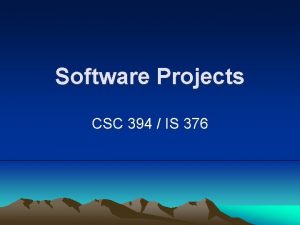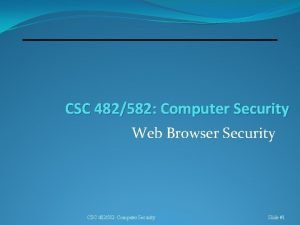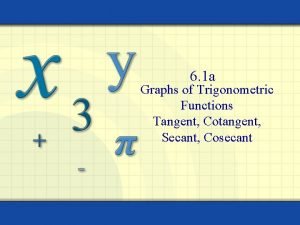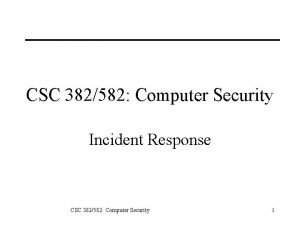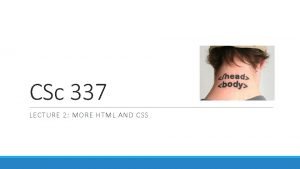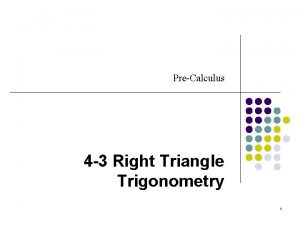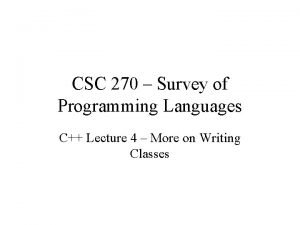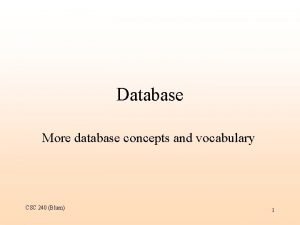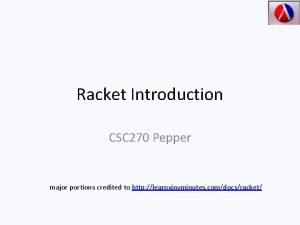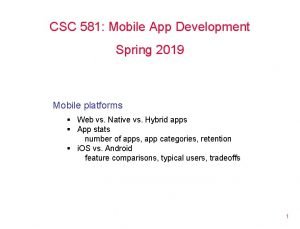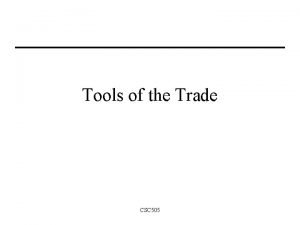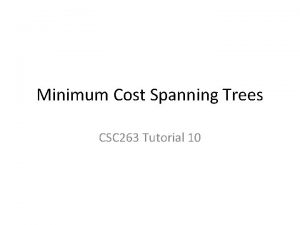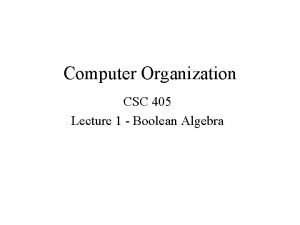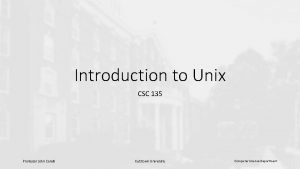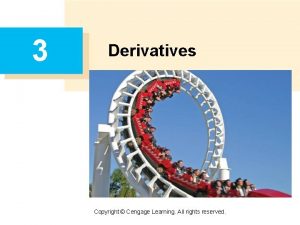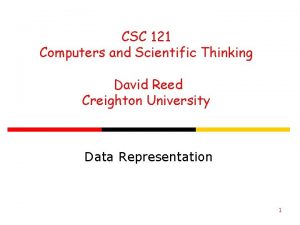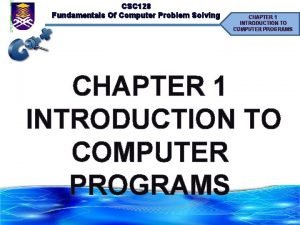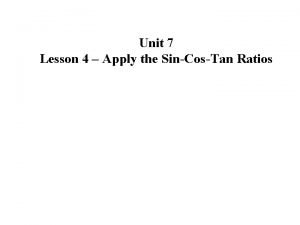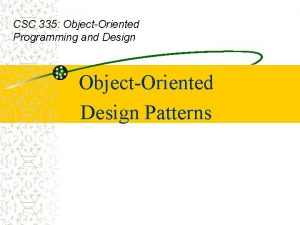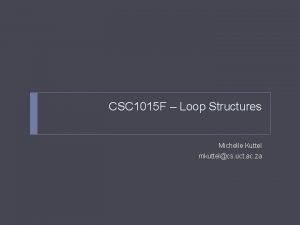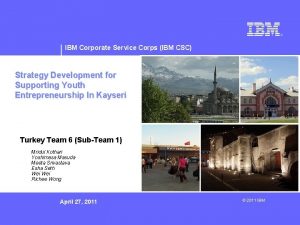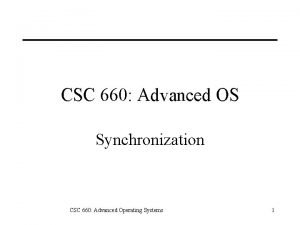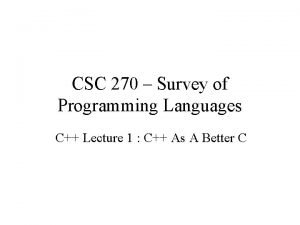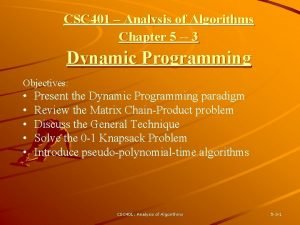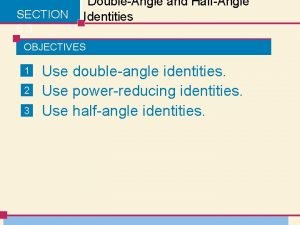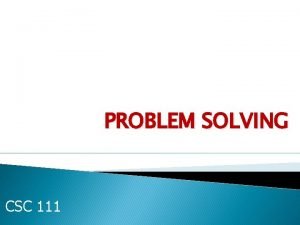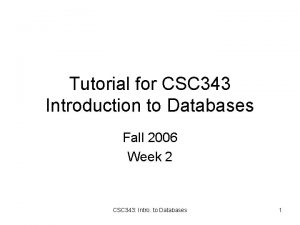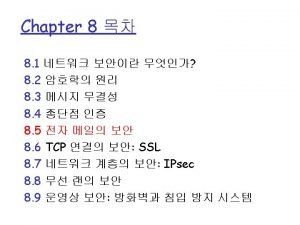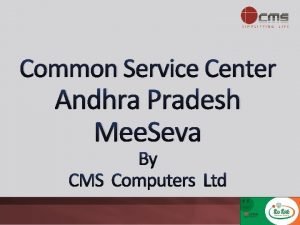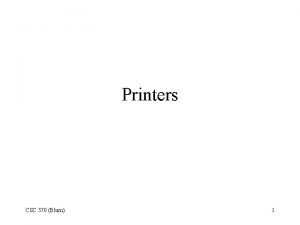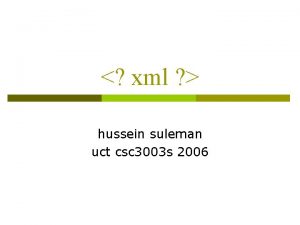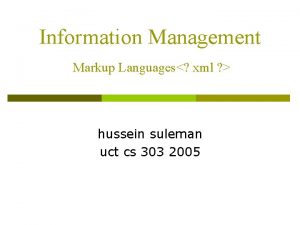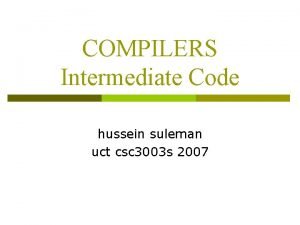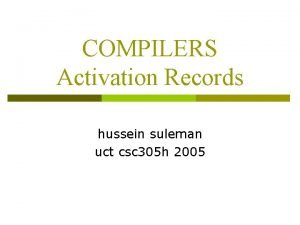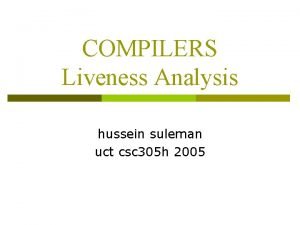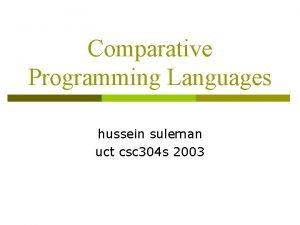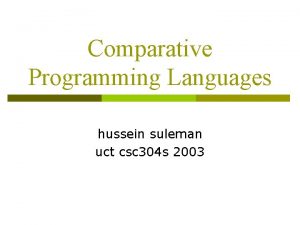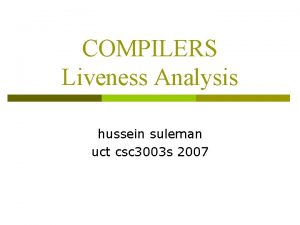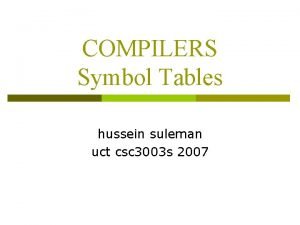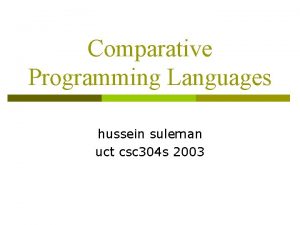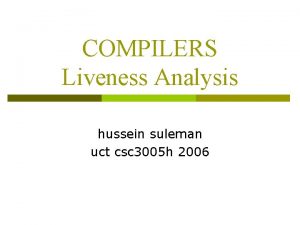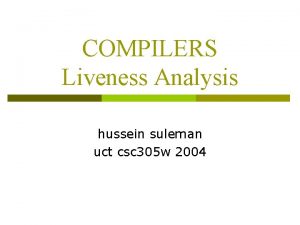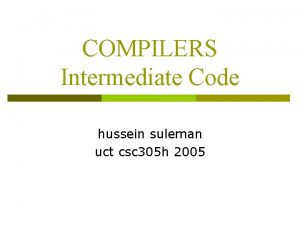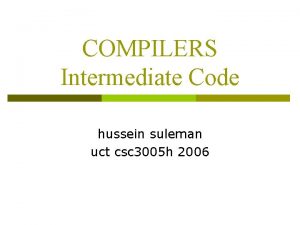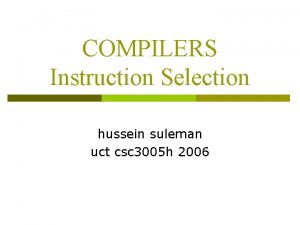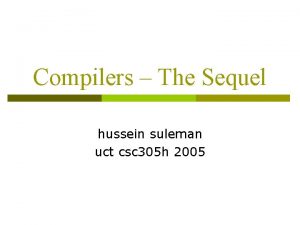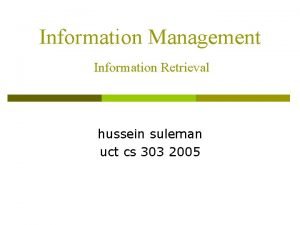xml hussein suleman uct csc 3002 f 2007



























































































































- Slides: 123

<? xml ? > hussein suleman uct csc 3002 f 2007

Outline p p p Markup Languages and XML Structure XML Parsing Namespaces XML Schema Metadata in XML XPath XSL – XSLT XSL – FO XQuery XML Databases References

Markup Languages and XML

Markup refers to auxiliary information (a. k. a. tags) that is interspersed with text to indicate structure and semantics. p Examples: p n n p La. Te. X uses markup to specify formatting (e. g. , hspace) HTML uses markup to specify structure (e. g. , <p>) A markup language specifies the syntax and semantics of the markup tags. Is La. Te. X outdated because of its markup language

Markup Example p Plain text n p Marked up text n p The brown fox jumped over the lazy dog. *paragraphstart*The *subjectstart*quick brown fox*subjectend* *verbstart*jumped*verbend* over the Can we *objectstart*lazy build a dog*objectend*. *paragraphend* parser Advantages: n n Aids semantic understanding. Supports automatic translation to other formats. for this ML?

SGML p Standard Generalised Markup Language (SGML) specifies a standard format for text markup. All SGML documents follow a Document Type Definition (DTD) that specifies the structure. n <!DOCTYPE uct PUBLIC "-//UCT//DTD SGML//EN"> <title>test SGML document <author email=‘pat@cs. uct. ac. za’ office=410 lecturer >Pat Pukram <version> Why don’t we need a closing title tag? <number>1. 0 </version>

HTML p p Hyper. Text Markup Language (HTML) specifies standard structure/formatting for linked documents on the WWW, as a subset of SGML defines general framework – HTML defines semantics for a specific application. n <html><head><title>test HTML document</title></head> <body> <h 1>Author</h 1> <p>Pat Pukram Lecturer Email: pat@cs. uct. ac. za Office: 410 </p> <h 1>Version</h 1> <p>1. 0</p> </body> </html>

XML p e. Xtensible Markup Language (XML) is a subset of SGML to ease adoption, especially for WWW use. n <uct> <title>test XML document</title> <author email=“pat@cs. uct. ac. za” office=“ 410” type=“lecturer”>Pat Pukram</author> <version> <number>1. 0</number> </version> </uct>

Relationship HTML v 4. 0 XHTML XML v 1. 0 STRUCTURE SEMANTICS SGML

XML Primer p An XML document is a serialised segment of text which follows the XML standard. p p (http: //www. w 3. org/TR/REC-xml) Documents may contain n n n XML declaration DTDs text elements processing instructions comments entity references

XML Sample XML declaration comment <? xml version=“ 1. 0”? > <!-– Sample XML file --> <!-– Hussein Suleman --> <!DOCTYPE uct [ DTD <!ELEMENT uct (title, author+, version? )> <!ELEMENT title (#PCDATA)> <!ELEMENT author (#PCDATA)> <!ATTLIST author email CDATA #REQUIRED> <!ATTLIST author office CDATA #REQUIRED> <!ATTLIST author type CDATA “lecturer”> ]> root element start tag/element entity end tag/element text attribute <uct> <title> test < XML> document </title> <author email=“pat@cs. uct. ac. za” office=“ 410” type=“lecturer” > Pat Pukram </author> </uct>

Exercise 1: View XML Start the Firefox WWW browser. p Load the file uct 1. xml from the workshop folder. p Use the – and + buttons to collapse and expand subsections of the XML. p

Well-formedness p Well-formed XML documents have a single root element and properly nested matching start/end tags. one root, proper nesting multiple roots improper nesting <uct> <stuff>… </stuff> </uct> <uct> <otherstuff>… </otherstuff> </uct> <stuff>… </uct> </stuff>

Validity p p Valid XML documents strictly follow a DTD (or other formal type definition language). Well-formedness enforces the fundamental XML structure, while validity enforces domain-specific structure! Why validate? Catch errors, quality assurance, allow structural assumptions … SGML parsers, in contrast, had no concept of well -formedness so domain-specific structure had to be incorporated into the parsing phase.

Levels of Correctness 1. 2. Unicode encoding must not contain erroneous characters XML documents must be well-formed n n 3. if there is no single root, then it is an XML fragment if elements are not properly nested, it is not really XML! XML can be valid, conforming to a DTD, Schema or other formal description

Exercise 2: View XML Error Start the Firefox WWW browser. p Load the file uct_error 1. xml from the exercise folder. p Take note of the error and try to understand what it means. p

XML Structure

XML declaration p <? xml encoding=“UTF-8” version=“ 1. 0” standalone=“yes” ? > p Appears (optionally) as first line of XML document. “encoding” indicates how the individual bits correspond to character sets. “version” indicates the XML version (usually 1. 0). “standalone” indicates if external type definitions must be consulted in order to process the document correctly. p p p recommended for all: standalone recommended for most European languages: UTF-8

Unicode p p Most XML is encoded in ISO 10646 Universal Character Set (UCS or Unicode). Unicode at first supported 16 -bit characters, as opposed to ASCII’s 8 -bits – implying 65536 different characters from most known languages. This has since been expanded to 32 bits. The simplest encoding mapping this to 4 fixed bytes is called UCS-4. To represent these characters more efficiently, variable length encodings are used: UTF-8 and UTF-16 are standard. Common characters should take less space to store/transmit - less common characters can take more space!

UTF-16 p p p Basic Multilingual Plane (characters in the range 0 -65535) can be encoded using 16 -bit words. Endianness (if there are 2 bytes, which one is stored first) is indicated by a leading Byte Order Mark (BOM) e. g. , FF FE = little endian UTF-16. For more than 16 bits, characters can be encoded using pairs of words and the reserved D 800 -DFFF range. n p UTF-16 UCS-4 n p D 800 DC 00 = Unicode 0 x 00010000 D 800 DC 01 = Unicode 0 x 0001 D 801 DC 01 = Unicode 0 x 00010401 DBFFDFFF = Unicode 0 x 0010 FFFF D 801 -D 7 C 0 = 0041, DC 01 & 03 FF = 0001 (0041 << 10) + 0001 = 00010401 UCS-4 UTF-16 ? Ouch!

UTF-8 p p Optimal encoding for ASCII text since characters < #128 use 8 bits. Variable encoding thereafter n p UCS-4 UTF-8 n p p Unicode 7 -bit = 0 vvvvvvv Unicode 11 -bit = 110 vvvvvv Unicode 16 -bit = 1110 vvvvvv Unicode 21 -bit = 11110 vvvvvv 10 vvvvvv etc. 0001 AB 45 = 11010 101100 100101 11110 vvvvvv 10 vvvvvv = 11110000 100110101100 10100101 = F 09 AACA 5 UTF-8 UCS-4 ? UTF-8, like UTF-16, is self-segregating to detect code boundaries and prevent errors. You mean we can’t actually write XML with Notepad/vi ?

Document Type Definition (DTD) p p Defines structure of XML documents. Optionally appears at top of document or at externally referenced location (file). <!DOCTYPE uct [ <!ELEMENT uct (title, author+, version? )> <!ELEMENT title (#PCDATA)> <!ELEMENT author (#PCDATA)> <!ATTLIST author email CDATA #REQUIRED> <!ATTLIST author office CDATA #REQUIRED> <!ATTLIST author type CDATA “lecturer”> <!ELEMENT version (number)> <!ELEMENT number (#PCDATA)> ]> ELEMENT defines structure of elements. n p ()=list of children, +=one or more, *=zero or more, ? =optional, PCDATA=text ATTLIST defines attributes for each element. n #REQUIRED=required, “lecturer”=default, CDATA=text

Elements / Tags Basic tagging or markup mechanism. p All elements are delimited by < and >. p Element names are case-sensitive and cannot contain spaces (full character set can be found in spec). p Attributes can be added as spaceseparated name/value pairs with values enclosed in quotes (either single or double). p n <sometag attrname=“attrvalue”>

Element Structure p p Elements may contain other elements in addition to text. Start tags start with “<“ and end with “>”. End tags start with “</“ and end with “>”. Empty tags start with “<“ and end with “/>”. n n n p p Every start tag must have an end tag and must be properly nested. Not well-formed: n p <x><a>mmm<b>mmm</a>mmm</b></x> Well-formed: n p Empty tags are a shorthand for no content. Example: </br> is the same as <br/> To convert HTML into XHTML, all tags must be in either of the forms above! <x><a>mmm<b>mmm</b></a><b>mmm</b></x> Elements may be repeatable! Does this work in HTML?

Special attributes p xml: space is used to indicate if whitespace is significant or not. n p In general, assume all whitespace outside of tag structure is significant! xml: lang indicates the language of the element content. n Example p <p xml: lang=“en”>I don’t speak</p> Zulu <p xml: lang=“es”>No hablo</p> Zulu

Entities p p Entities begin with “&” and end with “; ”. Named entity references refer to (are macros for) previously defined textual content – usually defined in an external or internal DTD. n p Character entities correspond to Unicode characters. n p Example: © is assumed in HTML but in XML it can only be used if the ISOLat 1 entity list is included Example:  refers to decimal character number 23 &#x 0041; refers to hex character number 41 Predefined escape sequence entities: n < (<), > (>), ' (‘), " (“), & (&)

Byte Order Marker p The Byte Order Marker is an optional code at the very beginning of the file primarily to indicate endianness of UTF-16. n FF FE = little endian p n FE FF = big endian p p Unicode “ 0102 0304” stored as “ 01 02 03 04” Since it is the first code, it also suggests the base encoding (to be used in conjunction with the more specific encoding attribute). n n p Unicode “ 0102 0304” stored as “ 02 01 04 03” EF BB BF = UTF-8 FF FE 00 00 = UCS-4, little endian It is usually possible to use heuristics to determine encodings and endianness automatically from the first 4 bytes.

Exercise 3 a: XML to store data p Encode the following relational data in XML: title Markup & XML date 2006 users name machine vusi 12 john 24 nithia 36

Exercise 3 b: Handwritten XML p Open a text editor and type in your XML document. n n Start with an XML declaration! Leave out the BOM and use UTF-8 encoding. Save the file in the exercise folder with a “. xml” extension. p Open the file in Firefox to make sure it loads properly and is well-formed. p

Namespaces

XML Namespaces are used to partition XML elements into well-defined subsets to prevent name clashes. p If two XML DTDs define the tag “title”, which one is implied when the tag is taken out of its document context (e. g. , during parsing)? p Namespaces disambiguate the intended semantics of XML elements. p

Default Namespaces Every element has a default namespace if none is specified. p The default namespace for an element and all its children is defined with the special “xmlns” attribute on an element. p p p Example: <uct xmlns=“http: //www. uct. ac. za”> Namespaces are URIs, thus maintaining uniqueness in terms of a specific scheme. Universal Resource Locator (URL) = location-specific Universal Resource Name (URN) = location-independent Universal Resource Identifier (URI) = generic identifier

Explicit Namespaces Multiple active namespaces can be defined by using prefixes. Each namespace is declared with the attribute “xmlns: ns”, where ns is the prefix to be associated with the namespace. p The containing element and its children may then use this prefix to specify membership of namespaces other than the default. p p <uct xmlns=“http: //www. uct. ac. za” xmlns: dc=“http: //somedcns”> <dc: title>test XML document</dc: title> </uct>

Can you rewrite the last example? p For example n <uct: uct xmlns: uct=“http: //www. uct. ac. za”> <dc: title xmlns: dc=“http: //somedcns”>test XML document</dc: title> </uct: uct>

Exercise 4: Namespaces p Edit your XML file from Exercise 3 to include namespaces as follows: n title and date are in the namespace http: //purl. org/dc/elements/1. 1/ n all other data is in the namespace http: //www. cs. uct. ac. za/XMLworkshop/ Minimise the size of your XML by using only one definition of each namespace and shorter prefixes thereafter. p Make sure your XML file loads into Firefox. p

XML Parsing

Parsing XML parsers expose the structure as well as the content to applications, as opposed to regular file input where applications get only content or linear structure. p Applications are written to manipulate XML documents using APIs exposed by parsers. p application p api parser <? xml? > Two popular APIs: n n Simple API for XML (SAX) Document Object Model (DOM) XML, SAX, DOM … is everything a TLA?

SAX Simple API for XML (SAX) is event-based and uses callback routines or event handlers to process different parts of XML documents. p To use SAX: p n n p Register handlers for different events Parse document Textual data, tag names and attributes are passed as parameters to the event handlers.

SAX Example p Using handlers to output the content of each node, the following output can be trivially generated: n n n n start document start tag : uct What start tag : title happened to content : test XML document the end tag : title attributes? start tag : author content : Pat Pukram end tag : author pseudo-code: start tag : version start tag : number start. Callback { output “start tag: “, tag } content : 1. 0 end tag : number … end tag : version main_program end tag : uct { register_starthandler (start. Callback) end document } … do_parse

DOM Document Object Model (DOM) defines a standard interface to access specific parts of the XML document, based on a treestructured model of the data. p Each node of the XML is considered to be an object with methods that may be invoked on it to set/retrieve its contents/structure or navigate through the tree. p DOM v 1 and v 2 are W 3 C standards. DOM 3 is a (newer) standard as of April 2004. p W 3 C?

DOM Tree document whitespace title test XML document whitespace uct whitespace author Pat Pukram whitespace version whitespace number Attribute List email=pat@cs. uct. ac. za office=410 type=lecturer 1. 0 whitespace

DOM Example p Step-by-step parsing n p # create instance of parser my $parser = new DOMParser; # parse document my $document = $parser->parsefile (‘uct. xml’); # get node of root tag my $root = $document->get. Document. Element; # get list of title elements my $title = $document->get. Elements. By. Tag. Name (‘title’); # get first item in list my $firsttitle = $title->item(0); Perl is popular for its # get first child – text content text-processing my $text = $firsttitle->get. First. Child; capabilities. # print actual text print $text->get. Data; Java is popular because Quick-and-dirty approach n of its libraries and servlet support. my $parser = new DOMParser; my $document = $parser->parsefile (‘uct. xml’); print $document->get. Document. Element->get. Elements. By. Tag. Name (‘title’)->item(0)->get. First. Child->get. Data;

DOM Interface subset 1/3 p Document n attributes p n document. Element – top element in document tree methods create. Element (tag) – creates and returns element ‘tag’ p create. Element. NS (ns, tag) – creates and returns element ‘tag’ in namespace ‘ns’ p create. Text. Node (text) – creates and returns text node with content ‘text’ p … p

DOM Interface subset 2/3 p Node n attributes p p p p p n node. Name – name of any node. Value – value of text or comment node. Type – type of node parent. Node – node one level higher up in the tree child. Nodes – list of children nodes first. Child – first child of current node last. Child – last child of current node previous. Sibling – previous node with same parent next. Sibling – next node with same parent attributes – list of name/value pairs methods p p p insert. Before (newchild, pos) – inserts newchild before pos replace. Child (new, old) – replaces child node old with new remove. Child (old) – removes child node old append. Child (new) – adds child node new to end of list has. Child. Nodes – returns whether or not there are children

DOM Interface subset 3/3 p Element (which is also a Node) n methods p p Node. List n attributes p n length – number of nodes in list methods p p get. Attribute (name) – returns value associated with name set. Attribute (name, val) – sets value for name get. Elements. By. Tag. Name (tag) – returns list of nodes from among children that match tag item (pos) – returns the node at position pos Character. Data (which is also a Node) n attributes p data – textual data

DOM Bindings DOM has different bindings (correspondence between abstract API and language-specific use) in different languages. p Each binding must cater for how the document is parsed – this is not part of DOM. p In general, method names and parameters are consistent across bindings. p Some bindings define extensions to the DOM e. g. , to serialise an XML tree. p

SAX vs. DOM p p DOM is a W 3 C standard while SAX is a community -based “standard”. DOM is defined in terms of a languageindependent interface while SAX is specified for each implementation language (with Java being the reference). DOM requires reading in the whole document to create an internal tree structure while SAX can process data as it is parsed. In general, DOM uses more memory to provide random access. there is another … actually, others

XML Schema

XML Schema specifies the type of an XML document in terms of its structure and the data types of individuals nodes. p It replaces DTDs – it can express everything a DTD can express plus more. p Other similar languages are RELAX and Schematron, but XML Schema is a W 3 C standard so has more support. p

Schema structure p Elements are defined by n <element name=“…” type=“…” min. Occurs=“…” max. Occurs=“…”> name refers to the tag. p type can be custom-defined or one of the standard types. Common predefined types include string, integer and any. URI. p min. Occurs and max. Occurs specify how many occurrences of the element may appear in an XML document. unbounded is used to specify no upper limits. p p Example n <element name=“title” type=“string” min. Occurs=“ 1” max. Occurs=“ 1”/>

Sequences p Sequences of elements are defined using a complex. Type container. n p <complex. Type> <sequence> <element name=“title” type=“string”/> <element name=“author” type=“string” max. Occurs=“unbounded”/> </sequence> </complex. Type> Note: Defaults for both min. Occurs and max. Occurs are 1

Nested Elements p Instead of specifying an atomic type for an element as an attribute, its type can be elaborated as a structure. This is used to correspond to nested elements in XML. n <element name=“uct”> <complex. Type> <sequence> <element name=“title” type=“string”/> <element name=“author” type=“string” max. Occurs=“unbounded”/> </sequence> </complex. Type> </element>

Extensions p Extensions are used to place additional restrictions on the content of an element. n Content must be a value from a given set: p n <element name=“version”> <simple. Type> <restriction base=“string”> <enumeration value=“ 1. 0”/> <enumeration value=“ 2. 0”/> </restriction> </simple. Type> </element> Content must conform to a regular expression: p <element name=“version”> <simple. Type> <restriction base=“string”> <pattern value=“[1 -9]. [0 -9]+”/> </restriction> </simple. Type> </element>

Attributes p Attributes can be defined as part of complex. Type declarations. p <element name=“author”> <complex. Type> <simple. Content> <extension base=“string”> <attribute name=“email” type=“string” use=“required”/> <attribute name=“office” type=“integer” use=“required”/> <attribute name=“type” type=“string”/> </extension> </simple. Content> </complex. Type> </element>

Named Types p Types can be named and referred to by name at the top level of the XSD. n <element name=“author” type=“uct: author. Type”/> <complex. Type name=“author. Type”> <simple. Content> <extension base=“string”> <attribute name=“email” type=“string” use=“required”/> <attribute name=“office” type=“integer” use=“required”/> <attribute name=“type” type=“string”/> </extension> </simple. Content> </complex. Type>

Other Content Models p Instead of sequence, n n choice means that only one of the children may appear. all means that each child may appear or not, but at most once each. Many more details about content models can be found in specification!

Schema Namespaces p Every schema should define a namespace for its elements, and for internal references to types n <schema xmlns=“http: //www. w 3. org/2001/XMLSchema” target. Namespace=“http: //www. uct. ac. za” xmlns: uct=“http: //www. uct. ac. za”> <element name=“author” type=“uct: author. Type”/> <complex. Type name=“author. Type”> <simple. Content> <extension base=“string”> <attribute name=“email” type=“string” use=“required”/> <attribute name=“office” type=“number” use=“required”/> <attribute name=“type” type=“string”/> </extension> </simple. Content> </complex. Type> </schema>

Full Schema 1/2 p <schema xmlns=“http: //www. w 3. org/2001/XMLSchema” target. Namespace=“http: //www. uct. ac. za” xmlns: uct=“http: //www. uct. ac. za” element. Form. Default=“qualified” attribute. Form. Default=“unqualified” > <complex. Type name=“author. Type”> <simple. Content> <extension base=“string”> <attribute name=“email” type=“string” use=“required”/> <attribute name=“office” type=“integer” use=“required”/> <attribute name=“type” type=“string”/> </extension> </simple. Content> </complex. Type> <complex. Type name=“version. Type”> <sequence> <element name=“number”> <simple. Type> <restriction base=“string”> <pattern value=“[1 -9]. [0 -9]+”/> </restriction> </simple. Type> </element> </sequence> </complex. Type>

Full Schema 2/2 p <complex. Type name=“uct. Type”> <sequence> <element name=“title” type=“string”/> <element name=“author” type=“uct: author. Type”/> <element name=“version” type=“uct: version. Type”/> </sequence> </complex. Type> <element name=“uct” type=“uct: uct. Type”/> </schema>

Binding XML Instances to Schemata p p In order to specify the XML Schema for a particular XML document, use the schema. Location attribute in the root tag (and elsewhere if necessary). schema. Location contains a space-separated list of pairs of namespaces and the associated URLs of XML Schema definitions. n p schema. Location=“namespace schema. URL” schema. Location is defined in the W 3 C’s XMLSchema-instance namespace so this must be defined as well. n xmlns: xsi=“http: //www. w 3. org/2001/XMLSchemainstance” xsi: schema. Location=“namespace schema. URL”

Qualified Valid XML p <uct xmlns=“http: //www. uct. ac. za” xmlns: xsi=“http: //www. w 3. org/2001/XMLSchema-instance” xsi: schema. Location=“http: //www. uct. ac. za uct. xsd” > <title>test XML document</title> <author email=“pat@cs. uct. ac. za” office=“ 410” type=“lecturer”>Pat Pukram</author> <version> <number>1. 0</number> </version> </uct> cool trick: use one of Xerces’s sample programs, like dom. Counter with a “-v” parameter, to do Schema validation!

Validating XML (using Schema) p Using an online service n p http: //www. w 3. org/2001/03/webdata/xsv Running validator from command-line #!/bin/sh export CLASSPATH=/usr/local/share/xerces 2_4_0/xml. Parser. APIs. jar: /usr/local/share/xerces 2_4_0/xerces. Impl. jar: /usr/local/share/xerces 2_4_0/xerces. Samples. jar /usr/local/jdk 1. 4. 2/bin/java Dproxy. Host=cache. uct. ac. za -Dproxy. Port=8080 dom. Counter -s -v -f -p dom. wrappers. Xerces $1 p Embedding validator in program n Parse the document with a validation switch turned on – validation is a core part of the parser (e. g. , Xerces).

W 3 C Schema Validator

Exercise 5 a: XML Schema Validation p p p Open a Command Prompt window (usually from Accessories on Win. XP). Change directory to the exercise folder. Type the command (on one line): n n java –classpath xerces. Impl. jar; xerces. Samples. jar dom. Counter -v -s -f uct 1. xml Output should be: p n p [Error] uct 1. xml: 1: 6: cvc-elt. 1: Cannot find the declaration of element 'uct'. uct 1. xml: 731; 40; 0 ms (5 elems, 3 attrs, 0 spaces, 56 chars) This is because the validator cannot find a schema. Note that the second line prints statistics on the XML since that is the function of dom. Counter – this is not part of the validation.

Exercise 5 b: XML Schema Validation p Type the command: n java –classpath xerces. Impl. jar; xerces. Samples. jar dom. Counter -v -s -f uct 2. xml n Output should be: p n [Error] uct 2. xml: 1: 35: cvc-elt. 1: Cannot find the declaration of element 'uct'. uct 2. xml: 731; 30; 0 ms (5 elems, 4 attrs, 0 spaces, 56 chars) Now, even though there is a namespace, there is still no schema declared.

Exercise 5 c: XML Schema Validation p Type the command: n java –classpath xerces. Impl. jar; xerces. Samples. jar dom. Counter -v -s -f uct 3. xml n Output should be: p n uct 3. xml: 821; 30; 0 ms (5 elems, 6 attrs, 0 spaces, 56 chars) This time no errors are reported because the XML is well-formed, valid and connected to its Schema using the right namespace and Schema URL.

Exercise 5 d: XML Schema Validation p Type the command: n n java –classpath xerces. Impl. jar; xerces. Samples. jar dom. Counter -v -s -f uct_error 1. xml Output should be: p n n [Error] uct_error 1. xml: 1: 6: cvc-elt. 1: Cannot find the declaration of element ‘uct'. [Fatal Error] uct_error 1. xml: 7: 6: The element type "number" must be terminated by the matching end-tag "</number>". The first error occurs because there is no namespace and schema. Location. The second error is fatal because the XML is not well-formed!

Exercise 5 e: XML Schema Validation p Type the command: n java –classpath xerces. Impl. jar; xerces. Samples. jar dom. Counter -v -s -f uct_error 2. xml n Output should be: p n [Error] uct_error 2. xml: 11: 14: cvc-complextype. 2. 4. d: Invalid content was found starting with element 'abstract'. No child element is expected at this point. uct_error 2. xml: 911; 40; 0 ms (6 elems, 6 attrs, 0 spaces, 63 chars) The XML is invalid because “abstract” is not defined in the schema.

Exercise 5 f: XML Schema Validation p Type the command: n java –classpath xerces. Impl. jar; xerces. Samples. jar dom. Counter -v -s -f uct_error 3. xml n Output should be: p n [Error] uct_error 3. xml: 6: 66: cvc-complextype. 2. 4. a: Invalid content was found starting with element 'author'. One of '{"http: //www. uct. ac. za": title}' is expected. uct_error 3. xml: 891; 40; 0 ms (4 elems, 6 attrs, 0 spaces, 35 chars) The XML is invalid because the title element is required but is missing.

Exercise 5 g: XML Schema Validation p Type the command: n n java –classpath xerces. Impl. jar; xerces. Samples. jar dom. Counter -v -s -f uct_error 4. xml Output should be: p n [Error] uct_error 4. xml: 7: 11: cvc-complextype. 2. 4. a: Invalid content was found starting with element 'title'. One of '{"http: //www. uct. ac. za": author}' is expected. uct_error 4. xml: 901; 30; 0 ms (6 elems, 6 attrs, 0 spaces, 73 chars) The XML is invalid because there is a second title and only one is defined in the schema.

XPath

XPath XML Path Language (XPath) is a language to address particular nodes or sets of nodes of an XML document. p Using XPath expressions we can write precise expressions to select nodes without procedural DOM statements. p Examples: p n n n uct/title uct/version/number uct/author/@office

XPath Syntax Expressions are separated by “/”. p In general, each subexpression matches one or more nodes in the DOM tree. p Each sub-expression has the form: p n n p axis: : node[condition 1][condition 2]… where axis can be used to select children, parents, descendents, siblings, etc. Shorthand notation uses symbols for the possible axes.

XPath Shorthand Expression What it selects in current context title “title” children * All children @office “office” attribute author[1] First author node /uct/title[last()] Last title within uct node at top level of document //author All author nodes that are descendent from top level . Context node . . Parent node version[number] Version nodes that have “number” children version[number=‘ 1. 0’] Version nodes for which “number” has content of “ 1. 0”

XPath Example 1 document uct title uct/title context node uct author uct/author version uct/version test XML document Pat Pukram number uct/version/number Attribute List 1. 0 email=pat@cs. uct. ac. za office=410 type=lecturer uct/author/@office

XPath Example 2 context node document uct title . . /title . . author . version. . /version test XML document Pat Pukram number. . /version/number Attribute List 1. 0 email=pat@cs. uct. ac. za office=410 type=lecturer @office

XPath Exercise document context node uct title test XML document author Pat Pukram Attribute List email=pat@cs. uct. ac. za office=410 type=lecturer version number 1. 0

XSL - XSLT

XSL XML Stylesheet Language (XSL) is used to convert structured data in XML to a “human-friendly” representation. p 2 -step process: Philosophically, p n n p Transform XML data (XSLT) Process formatting instructions and generate output (XSL-FO) besides programmers, nobody should ever have to read/write XML! In systems that are WWW-based, the first step is more useful – XSL Transformations (XSLT) – as XHTML is directly “processed” by browsers.

XSLT is a declarative language, written in XML, to specify transformation rules for XML fragments. p XSLT can be used to convert any arbitrary XML document into XHTML or other XML formats (e. g. , different metadata formats). p Example: p n <template match=“uct: author”> <dc: creator> <value-of select=“. ”/> </dc: creator> </template>

XSLT Basic Idea source XML <uct xmlns="http: //www. uct. ac. za"> <title>test XML document</title> </uct> XSLT <xsl: stylesheet version='1. 0' xmlns: xsl='http: //www. w 3. org/1999/XSL/Transform' xmlns: uct='http: //www. uct. ac. za' xmlns: uwc='http: //www. uwc. ac. za' > <xsl: template match="uct: uct"> <uwc: uwc> <uwc: title>test XML document</uwc: title> </uwc: uwc> </xsl: template> </xsl: stylesheet> <? xml version="1. 0"? > <uwc: uwc xmlns: uwc='http: //www. uwc. ac. za' transformed XML xmlns: uct='http: //www. uct. ac. za' > <uwc: title>test XML document</uwc: title> </uwc: uwc>

Applying XSLT Transformations p Running processor from command-line n p xsltproc uct. xsl uct. xml Running processor from within browser (static page) <? xml version="1. 0"? > <? xml-stylesheet type="text/xsl" href=“uct. xsl"? > p Embedding processor in program var processor = new XSLTProcessor (); var data. XML = document. implementation. create. Document("", null); data. XML. async = false; data. XML. load(“uct. xml"); var data. XSL = document. implementation. create. Document("", null); data. XSL. async = false; data. XSL. load(‘uct. xsl’); processor. reset(); processor. import. Stylesheet(data. XSL);

XSLT Templates of replacement XML are specified along with criteria for matching in terms of XPath expressions. p XSLT processors attempt to match the root XML tag with a template. If this fails they descend one level and try to match each of the root’s children, etc. p In the previous example, all occurrences of the “uct: uct” tag will be replaced by the contents of the template. p

XSLT Special Tags p Special tags in the XSL namespace are used to control transformation. p value-of, text, element n p apply-templates, call-template n p Apply template rules explicitly. variable, param, with-param n p Create nodes in result document. Local variables and parameter passing. if, choose, for-each n Procedural language constructs.

Creating Element nodes p element is replaced by an XML element with the indicated tag. n Example: p <element name=“dc: publisher”>UCT</element> <xsl: template match=“uct: uct”> <xsl: element name=“uwc: uwc”> <xsl: element name="uwc: title“> </xsl: element> </xsl: template> <uwc: uwc xmlns: uwc='http: //www. uwc. ac. za' xmlns: uct='http: //www. uct. ac. za' > <uwc: title/> </uwc: uwc>

Creating Text nodes p text is replaced by the textual content. n Example: p <text>1. 0</text> <xsl: template match=“uct: uct”> <uwc: uwc> <xsl: element name="uwc: title"> <xsl: text>test XML document</xsl: text> </xsl: element> </uwc: uwc> </xsl: template> <uwc: uwc xmlns: uwc='http: //www. uwc. ac. za' xmlns: uct='http: //www. uct. ac. za' > <uwc: title>test XML document</uwc: title> </uwc: uwc>

Element and Text Shorthand p Elements and text nodes can usually be included directly in templates. n Example p p Instead of <element name=“xxx”/> Use <xxx/> <xsl: template match=“uct: uct”> <uwc: uwc> <uwc: title> test XML document </uwc: title> </uwc: uwc> </xsl: template> <uwc: uwc xmlns: uwc='http: //www. uwc. ac. za' xmlns: uct='http: //www. uct. ac. za' > <uwc: title>test XML document</uwc: title> </uwc: uwc>

Copying values across p value-of is replaced with the textual content of the nodes identified by the XPath expression. n Example: p <value-of select=“uct: title”/> <xsl: template match=“uct: uct”> <uwc: uwc> <uwc: title> <xsl: value-of select=“uct: title”/> </uwc: title> </uwc: uwc> </xsl: template> <uwc: uwc xmlns: uwc='http: //www. uwc. ac. za' xmlns: uct='http: //www. uct. ac. za' > <uwc: title>test XML document</uwc: title> </uwc: uwc>

Applying Templates Explicitly p apply-templates explicitly and recursively applies templates to the specified nodes. n Example: p <apply-templates select=“uct: version”/> <xsl: template match="uct: uct"> <uwc: uwc> <uwc: title> <xsl: value-of select="uct: title"/> </uwc: title> <xsl: apply-templates select="uct: author"/> </uwc: uwc> </xsl: template> <xsl: template match="uct: author"> <uwc: author> <xsl: value-of select=". "/> </uwc: author> </xsl: template> <uwc: uwc xmlns: uwc='http: //www. uwc. ac. za' xmlns: uct='http: //www. uct. ac. za' > <uwc: title>test XML document</uwc: title> <uwc: author>Pat Pukram</uwc: author> </uwc: uwc>

Calling Templates p call-template calls a template like a function. This template may have parameters and must have a name attribute instead of a match. p Example: n <call-template name=“doheader”> <with-param name=“lines”>5</with-param> </call-template> <template name=“doheader”> <param name=“lines”>2</param> … </template>

Variables p variable sets a local variable in a template or globally. In XPath expressions, a $ prefix indicates a variable or parameter instead of a node. n Example: p p <variable name=“institution”>UCT</variable> <value-of select=“$institution”/> Expressions also can be inserted into attributes in generated nodes. Surround the expression with { and } to tell XSLT it is not a literal string. n Example: p <place institution=“{$institution}”/>

Procedural Constructs p Generate a tree of nodes if a condition holds. n p Generate a different tree of nodes, depending on which of a number of a conditions holds. n p <if test=“position()=last()”>…</if> <choose> <when test=“$val=1”>…</when> <otherwise>…</otherwise> </choose> Iterate over a set of nodes matching an expression and generate a tree for each. This has the same effect as apply-templates. n <for-each select=“uct: number”>…</for-each>

Full XSLT 1/2 <xsl: stylesheet version='1. 0' xmlns: xsl='http: //www. w 3. org/1999/XSL/Transform' xmlns: xsi='http: //www. w 3. org/2001/XMLSchema-instance' xmlns: uct='http: //www. uct. ac. za' xmlns='http: //www. w 3. org/1999/xhtml' exclude-result-prefixes='xsi uct' > <!- UCT to HTML transformation Hussein Suleman v 1. 0 : 10 May 2007 --> <xsl: output method="xml" omit-xml-declaration="yes" omit-namespace="html"/> <xsl: variable name="institution"> <xsl: text>UCT</xsl: text> </xsl: variable>

Full XSLT 2/2 <xsl: template match="uct: uct"> <html> <head> <title>UCT Information Page</title> </head> <body> <h 1><xsl: value-of select="uct: title"/></h 1> <hr/> <xsl: apply-templates select="uct: author"/> <h 2>Publisher</h 2><p><xsl: value-of select="$institution"/></p> <xsl: apply-templates select="uct: version"/> </body> </html> </xsl: template> <xsl: template match="uct: author"> <h 2>Author</h 2> <p><xsl: value-of select=". "/></p> </xsl: template> <xsl: template match="uct: version"> <h 2>Version</h 2> <p><xsl: value-of select="uct: number"/></p> </xsl: template> </xsl: stylesheet> note: this is not the simplest XSLT for this problem

Transformed XML (XHTML Source) <html xmlns="http: //www. w 3. org/1999/xhtml"> <head> <title>UCT Information Page</title> </head> <body> <h 1>test XML document</h 1> <hr/> <h 2>Author</h 2> <p>Pat Pukram</p> <h 2>Publisher</h 2> <p>UCT</p> <h 2>Version</h 2>1. 0</body> </html>

XHTML Rendered

Exercise 6: XSLT p p p View the uct. xsl stylesheet in your browser. In the workshop folder, copy uct 3. xml to uct 4. xml. Edit uct 4. xml and add the following line just below the XML declaration (or as the top line if there is no declaration). n p <? xml-stylesheet type="text/xsl" href="uct. xsl"? > View the uct 4. xml file in your browser. n n n It should appear in its transformed state (as HTML). View source to see the original file. Note that this is XML XHTML (because the end result is to view in a browser) but you do not always do this…

XSL - FO

XSL Formatting Objects XSL-FO is a language to specify the layout of elements on pages. p Page masters (templates) are first defined and then content is flowed onto the pages. p n p Formatting attributes are similar to CSS! XSLT is typically used to convert XML into XSL-FO, then an FO processor (such as Apache FOP) converts the FO into a document format (such as PDF).

Example XSL-FO <fo: root xmlns: fo="http: //www. w 3. org/1999/XSL/Format"> <fo: layout-master-set> <fo: simple-page-master margin-right="1 cm" margin-left="1 cm" margin-top="1 cm" margin-bottom="1 cm" pagewidth="210 mm" page-height="297 mm" master-name="first"> <fo: region-after extent="1 cm"/> <fo: region-body margin-top="1 cm" margin-bottom="2 cm" margin-left="1 cm" margin-right="1 cm"/> </fo: simple-page-master> </fo: layout-master-set> <fo: page-sequence master-reference="first"> <fo: flow-name="xsl-region-body"> <fo: block margin="0" padding="12 px 0" font-weight="bold" text-align="center" fontsize="20 pt" font-family="sans-serif">test XML document</fo: block> <fo: block margin="0" padding="12 px 0 6 px 0" font-size="12 pt" font-family="serif"><fo: inline fontweight="bold">Author</fo: inline> : Pat Pukram</fo: block> <fo: block margin="0" padding="12 px 0 6 px 0" font-size="12 pt" font-family="serif"><fo: inline fontweight="bold">Version</fo: inline> : 1. 0</fo: block> </fo: flow> </fo: page-sequence> </fo: root>

XSL-FO PDF Output

Example XSLT (XSL-FO) 1/3 <!- XSL FOP stylesheet to convert the UCT metadata record into FO suitable for FOP to convert into a PDF Hussein Suleman 1 August 2005 --> <xsl: stylesheet version='1. 0' xmlns: xsl='http: //www. w 3. org/1999/XSL/Transform' xmlns: source='http: //www. uct. ac. za' xmlns: fo='http: //www. w 3. org/1999/XSL/Format' xmlns: html='http: //www. w 3. org/1999/xhtml' > <xsl: output method="xml" omit-xml-declaration="yes"/>

Example XSLT (XSL-FO) 2/3 <xsl: template match="source: uct"> <fo: root> <fo: layout-master-set> <fo: simple-page-master margin-right="1 cm" margin-left="1 cm" margin-top="1 cm" margin-bottom="1 cm" page-width="210 mm" page-height="297 mm" master-name="first"> <fo: region-after extent="1 cm"/> <fo: region-body margin-top="1 cm" margin-bottom="2 cm" margin-left="1 cm" margin-right="1 cm"/> </fo: simple-page-master> </fo: layout-master-set> <fo: page-sequence master-reference="first"> <fo: flow-name="xsl-region-body"> <xsl: apply-templates select="*"/> </fo: flow> </fo: page-sequence> </fo: root> </xsl: template>

Example XSLT (XSL-FO) 3/3 <xsl: template match="source: title"> <fo: block margin="0" padding="12 px 0" font-weight="bold" text-align="center" font-size="20 pt" font-family="sans-serif"> <xsl: value-of select=". "/> </fo: block> </xsl: template> <xsl: template match="source: author"> <fo: block margin="0" padding="12 px 0 6 px 0" font-size="12 pt" font-family="serif"> <fo: inline font-weight="bold">Author</fo: inline> : <xsl: value-of select=". "/> </fo: block> </xsl: template> <xsl: template match="source: version"> <fo: block margin="0" padding="12 px 0 6 px 0" font-size="12 pt" font-family="serif"> <fo: inline font-weight="bold">Version</fo: inline> : <xsl: value-of select="source: number"/> </fo: block> </xsl: template> </xsl: stylesheet>

XQuery

XQuery specifies advanced functional queries over XML documents and collections. p XQuery is a superset of XPath 1. 0, and parallel specification for XPath 2. 0 and XSLT 2. 0. p

XQuery Expressions 1/2 p Primary expressions n n n p 12. 1, “Hello world” (literals) $firstauthor (variable) xq: string-concat () (function call) Path expressions n n n document(“test. xml”)//author para[5][@type="warning"] child: : chapter[child: : title='Intro']

XQuery Expressions 2/2 p Arithmetic/Comparison/Logic expressions n n n p $unit-price - $unit-discount //product[weight gt 100] 1 eq 1 and 2 eq 2 Sequence expressions n n (1, 2, (3)) (10, 1 to 4) (1 to 100)[. mod 5 eq 0] $seq 1 union $seq 2

FLWOR Expressions p For-Let-Where-Order. By-Return p Iterates over a sequence of nodes, with intermediate binding of variables. p Most useful for database-like “join” operations.

FLWOR Example for $d in fn: doc("depts. xml")//deptno let $e : = fn: doc("emps. xml")//emp[deptno = $d] where fn: count($e) >= 10 order by fn: avg($e/salary) descending return <big-dept> { $d, <headcount>{fn: count($e)}</headcount>, <avgsal>{fn: avg($e/salary)}</avgsal> } </big-dept> (from specification)

FLWOR For, Let for and let create a sequence of tuples with bound variables. p Can have multiple fors and multiple lets. p Multiple fors result in a Cartesian product of the sequences. p n p for $car in ("Ford", "Chevy"), $pet in ("Cat", "Dog") Multiple lets result in multiple intermediate variable bindings per tuple of nodes.

FLWOR Where, Order. By, Return where filters the list of tuples, by removing those that do not satisfy the expression. p return specifies result for each tuple. p order by specifies the expression to use to order the tuples – the expression can use nodes not included in the result. p n for $e in $employees order by $e/salary descending return $e/name

FLWOR for DB Joins <ucthons> { for $stud in fn: doc(“students. xml”)//student for $proj in fn: doc(“projects. xml”)//project[id = $stud/id] order by $stud/name return <honsproj> <studentname>{$stud/name}</studentname> <projectname>{$proj/name}</projectname> </honsproj> } </ucthons>

XML Databases

XML Databases must be Unicode-compliant! (usually UTF-8) p Options: p n n Blob: Store XML documents or fragments in tables. Tree: Store XML as sequence of nodes with child relationships explicitly indicated. Relation: Store XML in specialised tables/relations as defined by XML structure. Flat files: Store each XML document in a file.

Blob/Clob/etc. Id Test. XMLBlob <uct> <title>test XML document</title> <author email=“pat@cs. uct. ac. za” office=“ 410” type=“lecturer”>Pat Pukram</author> <version> <number>1. 0</number> </version> </uct>

Tree Representation Nodes Links Value Parent id Child id Element uct 1 2 2 Element title 2 3 3 Text test XML document 1 4 4 Element author 4 5 5 Attribute email pat@cs. uct. ac. za 6 Attribute office 410 4 6 7 Attribute type lecturer 4 7 8 Text Pat Pukram 4 8 9 Element version 1 9 10 Element number 9 10 11 Text 1. 0 10 11 Id Type 1 Label Note: Whitespace nodes have been ignored!

Relation Representation main table Institute Title Version. Number id uct test XML document 1. 0 1 id Author Email Office Type 1 Pat Pukram pat@cs. uct. ac. za 410 lecturer author table

Evaluation Blob: fast insert/select for XML documents, but slow querying. p Tree: fast location of single nodes and sequences of nodes, but slow to enforce structure of XML. p Relation: fast data query and extraction, but could be many tables and thus slow to insert/select XML documents. p Flat file: fast load/store, but slow queries. p Are we only interested in relational queries? Google-like queries?

that’s all folks!

References 1/3 p p p p Adler, Sharon, Anders Berglund, Jeff Caruso, Stephen Deach, Tony Graham, Paul Grosso, Eduardo Gutentag, Alex Milowski, Scott Parnell, Jeremy Richman and Steve Zilles (2001) Extensible Stylesheet Language (XSL) Version 1. 0, W 3 C. Available http: //www. w 3. org/TR/xsl/ Berners-Lee, Tim, Roy Fielding and Larry Masinter (1998) Uniform Resource Identifiers (URI): Generic Syntax, RFC 2396, Network Working Group. Available http: //www. ietf. org/rfc 2396. txt Boag, Scott, Don Chamberlin, Mary F. Fernández, Daniela Florescu, Jonathan Robie and Jérôme Siméon (2005). XQuery 1. 0: An XML Query Language, W 3 C Working Draft 4 April 2005, W 3 C. Available http: //www. w 3. org/TR/xquery/ Bourret, Ronald (1999), Declaring Elements and Attributes in an XML DTD. Available http: //www. rpbourret. com/xmldtd. htm Bradley, Neil (1998) The XML Companion, Addison-Wesley. Bray, Tim, Jean Paoli, C. M. Sperberg-Mc. Queen and Eve Maler (2000) Extensible Markup Language (XML) 1. 0 (Second Edition), W 3 C. Available http: //www. w 3. org/TR/REC-xml Clark, James (1999) XSL Transformations (XSLT) Version 1. 0, W 3 C. Available http: //www. w 3. org/TR/xslt Clark, James (1999) Associated Style Sheets with XML Documents, W 3 C Recommendation. Available http: //www. w 3. org/TR/xml-stylesheet/

References 2/3 p p p p Clark, James and Steve De. Rose (1999) XML Path Language (XPath) Version 1. 0, W 3 C. Available http: //www. w 3. org/TR/xpath Czyborra, Roman (1998), Unicode Transformation Formats: UTF-8 & Co. Available http: //czyborra. com/utf/ Dublin Core Metadata Initiative (2003) Dublin Core Metadata Element Set, Version 1. 1: Reference Description, DCMI. Available http: //dublincore. org/documents/dces/ Fallside, David C. (editor) (2001) XML Schema Part 0: Primer, W 3 C. Available http: //www. w 3. org/TR/xmlschema-0/ IMS Global Learning Consortium, Inc. (2001) IMS Learning Resource Meta. Data Information Model Version 1. 2. 1 Final Specification, http: //www. imsglobal. org/metadata/imsmdv 1 p 2 p 1/imsmd_infov 1 p 2 p 1. ht ml Lasher, R. and D. Cohen (1995) A Format for Bibliographic Records, RFC 1807, Network Working Group. Available http: //www. ietf. org/rfc 1807. txt Le Hors, Arnaud , Philippe Le Hégaret, Lauren Wood, Gavin Nicol, Jonathan Robie, Mike Champion, Steve Byrne (2000), Document Object Model Level 2 Core, W 3 C. Available http: //www. w 3. org/TR/2000/REC-DOM-Level-2 Core-20001113/

References 3/3 p p p SAX Project (2003) Quickstart. Available http: //www. saxproject. org/? selected=quickstart Thomson, Henry S. and Richard Tobin (2005) Validator for XML Schema, W 3 C. Available http: //www. w 3. org/2001/03/webdata/xsv Visual Resources Association Data Standards Committee (2002) VRA Core Categories, Version 3. 0. Available http: //www. vraweb. org/vracore 3. htm
 Hussein suleman
Hussein suleman Hussein suleman
Hussein suleman Reporaproblem
Reporaproblem Uct computer science
Uct computer science Hussein suleman
Hussein suleman Example 3002
Example 3002 Suleman ahmer
Suleman ahmer Uct air force
Uct air force Uct hpc
Uct hpc From [email protected] sat jan 5 09:14:16 2008
From [email protected] sat jan 5 09:14:16 2008 Uct public access
Uct public access Uct summer school
Uct summer school Uct information management
Uct information management Hrec uct
Hrec uct Uct algorithm
Uct algorithm Nadia chalkley uct
Nadia chalkley uct Hantam community education trust
Hantam community education trust Uct
Uct Redcap uct
Redcap uct University of chemistry and technology prague tuition fee
University of chemistry and technology prague tuition fee Uct
Uct Uct software engineering
Uct software engineering Eduroam uct
Eduroam uct Fbml
Fbml Nadya hussein
Nadya hussein Saddam hussein
Saddam hussein Laila hussein
Laila hussein Dr rania hussein
Dr rania hussein Saddam hussein
Saddam hussein Emptiness
Emptiness Karen hussein
Karen hussein Saddam hussein
Saddam hussein Bassam hussein
Bassam hussein Alex hoffer stanford
Alex hoffer stanford Dr hussein saad
Dr hussein saad Bleibel
Bleibel Hassine bey
Hassine bey Advantages of selective primary health care
Advantages of selective primary health care Wal hamdu lillahi rabbil 'alamin
Wal hamdu lillahi rabbil 'alamin Dr. hussein shaqra
Dr. hussein shaqra George hw bush apush
George hw bush apush Ananda sabil hussein
Ananda sabil hussein Taha hussein challenges
Taha hussein challenges Dr rania hussein
Dr rania hussein Audrey a. sedal
Audrey a. sedal Csc // indexing
Csc // indexing Sohcahtoa secant
Sohcahtoa secant Unix oses
Unix oses Csc 240 degrees
Csc 240 degrees Csc inspection
Csc inspection Csc algebra
Csc algebra Tan sec identities
Tan sec identities Csc 143
Csc 143 Csc tankkaart
Csc tankkaart Csc 317
Csc 317 Cos = adjacent/hypotenuse
Cos = adjacent/hypotenuse Csc 337
Csc 337 Csc 370
Csc 370 Assignment csc 128
Assignment csc 128 Csc picture size in inches
Csc picture size in inches Csc 660
Csc 660 Csc 282 rochester
Csc 282 rochester Csc a
Csc a Csc 600
Csc 600 Csc gymnastics
Csc gymnastics Kimmo koski csc
Kimmo koski csc Csc 660
Csc 660 Csc 405
Csc 405 Sec csc cot
Sec csc cot Csc^-1 derivative
Csc^-1 derivative Individual performance contract rating (ipcr) form
Individual performance contract rating (ipcr) form Csc 240
Csc 240 Csc 407
Csc 407 Wavez csc
Wavez csc Csc 110 university of arizona
Csc 110 university of arizona Csc 450
Csc 450 Csc-005
Csc-005 Csc 370
Csc 370 Csc 394
Csc 394 Cygnus csc
Cygnus csc Csc browser
Csc browser Tan and cot graph
Tan and cot graph Csc
Csc Scriptdom slang
Scriptdom slang Sin 60
Sin 60 Csc 270
Csc 270 Csc(240)
Csc(240) Csc(270)
Csc(270) Csc mobile app
Csc mobile app 505 design
505 design Csc longin
Csc longin Csc algebra
Csc algebra Csc 135°
Csc 135° Derivatives formulas
Derivatives formulas Csc 121
Csc 121 Csc ncsu
Csc ncsu Bmi solving example
Bmi solving example Unit 7 lesson 4
Unit 7 lesson 4 Builder design pattern uml diagram
Builder design pattern uml diagram Wet amd
Wet amd Michelle kuttel
Michelle kuttel Ibm service corps
Ibm service corps Csc 660
Csc 660 Csc 270
Csc 270 Csc 253
Csc 253 Ncsu csc senior design
Ncsu csc senior design Csc dawagram
Csc dawagram Csc
Csc Csc 401
Csc 401 Double.angle identity
Double.angle identity Csc.weebly
Csc.weebly Problem solving flowchart examples
Problem solving flowchart examples Csc 252
Csc 252 Csc
Csc Csc 343
Csc 343 노트20 csc 변경
노트20 csc 변경 Multimedia becomes interactive multimedia when
Multimedia becomes interactive multimedia when Csc skill center banner
Csc skill center banner Write around cache
Write around cache Apcmscsconline
Apcmscsconline Csc 225
Csc 225 Said kerrache
Said kerrache Csc charge
Csc charge Csc a
Csc a


